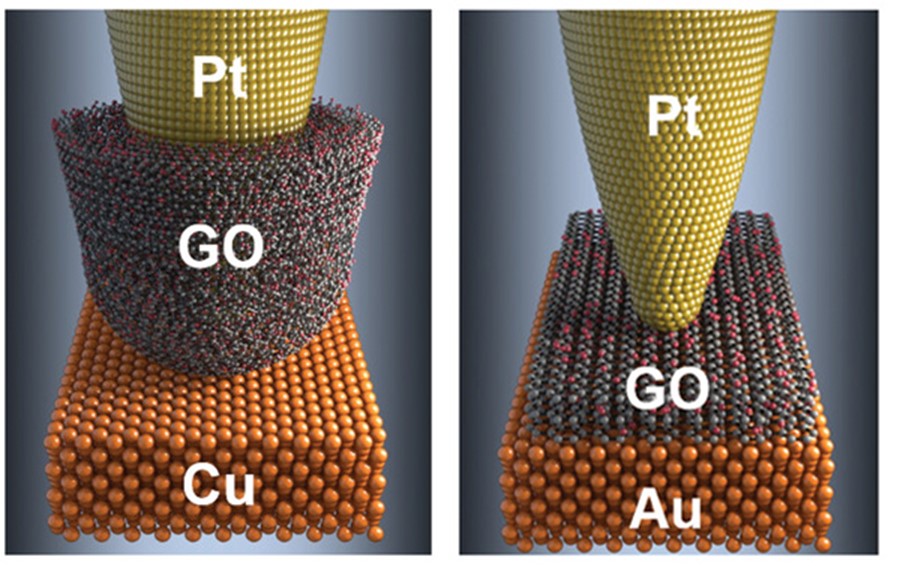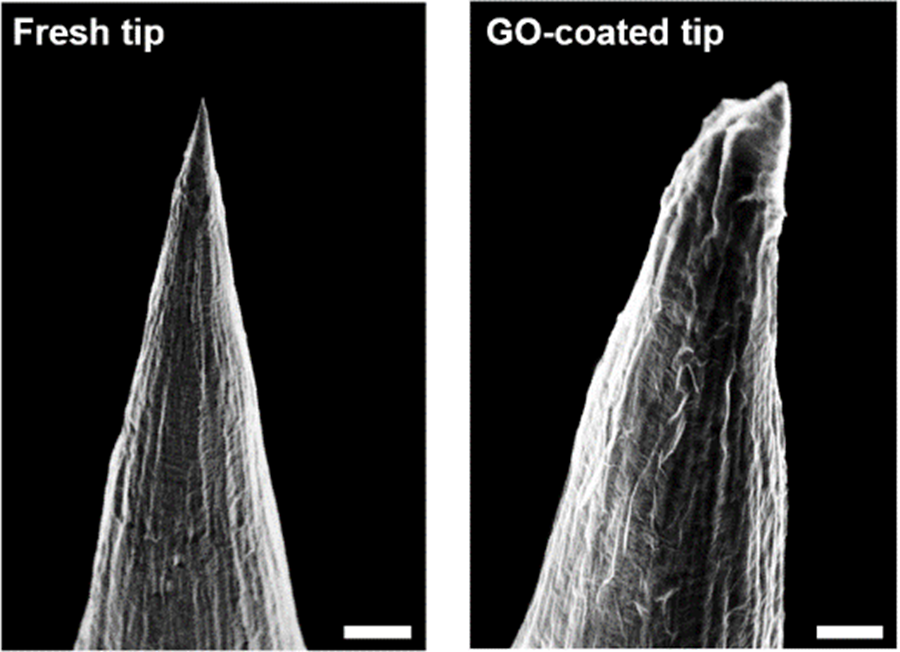Brain-inspired devices with graphene oxide
Ultra-small devices show nano-synaptic responses with low power consumption.
An international research team, including researchers at Graphene Flagship Partners CNRS (France), The University of Cambridge (UK) and Technion (Israel), in collaboration with the group of Prof. Mario Lanza at King Abdullah University of Science and Technology (KAUST, Saudi Arabia), built ultra-small devices made with graphene oxide (GO), that mimic a connection between two neurons. These devices are known as memristors, a portmanteau of memory resistor.
The potential of neuromorphic computing
Over the years, transistors have become smaller and smaller, but computer circuits have not changed much. Neuromorphic computing can fundamentally transform the architecture of our computers, and allow us to perform faster computing operations. For example, it could speed up video rendering, information live-processing, big data analysis, and encryption systems for digital security.
Another issue with our traditional computers is power consumption. Computers suffer from the Von-Neumann bottleneck: the process of transferring data between the memory and the logic unit is extremely power-hungry. In comparison, a neuromorphic computing system computes and stores information in the same place, so the need for data transfer is eliminated. This type of computing tries to emulate what happens in the brain, and is based on electronic synapses. In the brain, biological synapses transmit electrochemical signals, produced by one or more neurons. In an artificial neural network, electronic synapses are the elements that compute electrical signals and can also retain memory after the power is turned off (non-volatile memory).
We are at the early stages of neuromorphic chip fabrication. State-of-the-art neuromorphic chips use six transistors to implement a single electronic synapse. However, memristors are much more efficient in terms of both power and space: one memristor can implement one electronic synapse.
Current industrial memristors have two states of resistance, emulating the 1s and 0s of binary code, but do not exhibit electro-synaptic plasticity – conductance modulation depending on the frequency of the applied electrical impulses. That is why researchers are racing to try innovative materials.
The new device enabled by graphene oxide
In this study, the researchers demonstrated nano-synaptic responses in a memristor made of GO sandwiched between two metals. One of the metals is the platinum-tip of a conductive atomic force microscope (CAFM), which measures the electric current flow between the tip and the GO layer.
"GO seemed like an obvious choice for this application; its intrinsic insulating properties, large lateral size and flexibility were key advantages over other solution-processed layered materials. This study represents an application of graphene-based materials that has great potential for enabling future technologies," says Stephen Hodge, who performed this work while at the Graphene Flagship partner University of Cambridge and is currently CTO of Graphene Flagship partner Versarien plc.
Small size, low power consumption and non-volatile conductance
Most studies used memristors bigger than 100 µm2, which do not meet the integration density required by the IT industry. In this study instead, the contact area between GO and the two electrodes was ~50 nm2, over three orders of magnitude smaller than previous experiments.
Since the researchers wanted to replicate neurons’ electrochemical pulses with their technical equipment, they modified the CAFM to apply short voltage pulses and measured the current that flowed to the other metal through the GO layer. Devices made with platinum, GO and gold could transmit the spike from the platinum tip to the gold layer, across the GO synapse.
The current increased with both amplitude and number of pulses: a response similar to that observed in biological excitatory synapses between two neurons. The device consumes ~3 μW, amongst the lowest power consumptions to date. The team also demonstrated non-volatile conductance: a step toward long-term plasticity, where changes in resistance remain stable for minutes or days.
“This work represents a big step-forward towards the realisation of ultra-scaled synapses for artificial neural network applications. The authors also managed to improve the nanosynapses’ computational performance and functionalities with reduced power consumption – a fundamental aspect, particularly important for portable applications,” says Gianluca Fiori, Deputy Leader of the Graphene Flagship’s Electronic Devices Work Package.
Andrea Ferrari, Science and Technology Officer of the Graphene Flagship, adds: “Graphene and related materials have great potential for neuromorphic computing. This work is an important step to showcase their performance. It also proves how the Graphene Flagship is able to foster collaborations both within and outside Europe, leading to significant progress in this ever increasing science and technology area”.
Reference
Hui, Fei, et al. "In Situ Observation of Low‐Power Nano‐Synaptic Response in Graphene Oxide Using Conductive Atomic Force Microscopy." Small (2021): 2101100.

Platinum/GO/copper nano-synapse with a contact area smaller than 500 nm2 and platinum/GO/gold nano-synapse with a contact area smaller than <50 nm2. Modified from: see reference.

Electron microscopy images of the CAFM tip before and after graphene oxide (GO) spray-coating. (Scale bars: 2.5 μm for left, 1 μm for right). Modified from: see reference.




